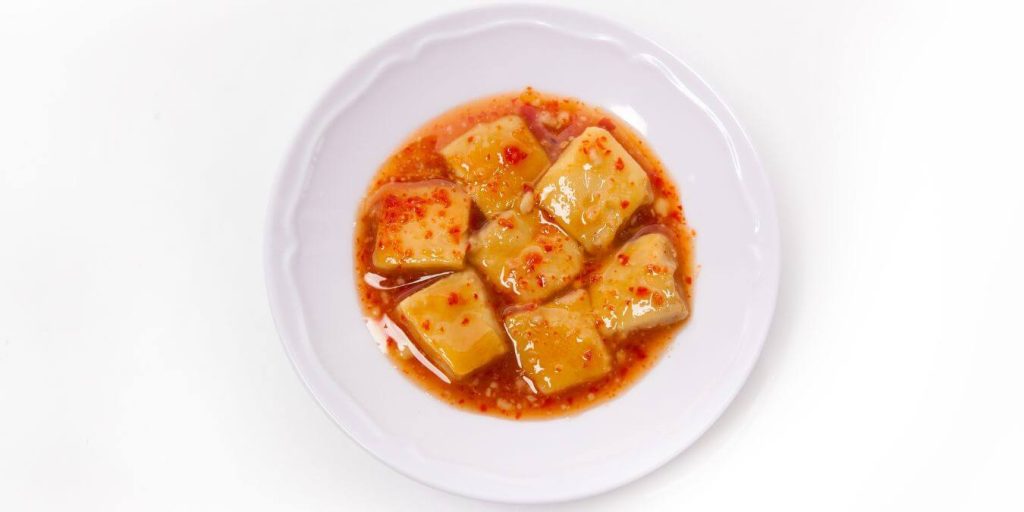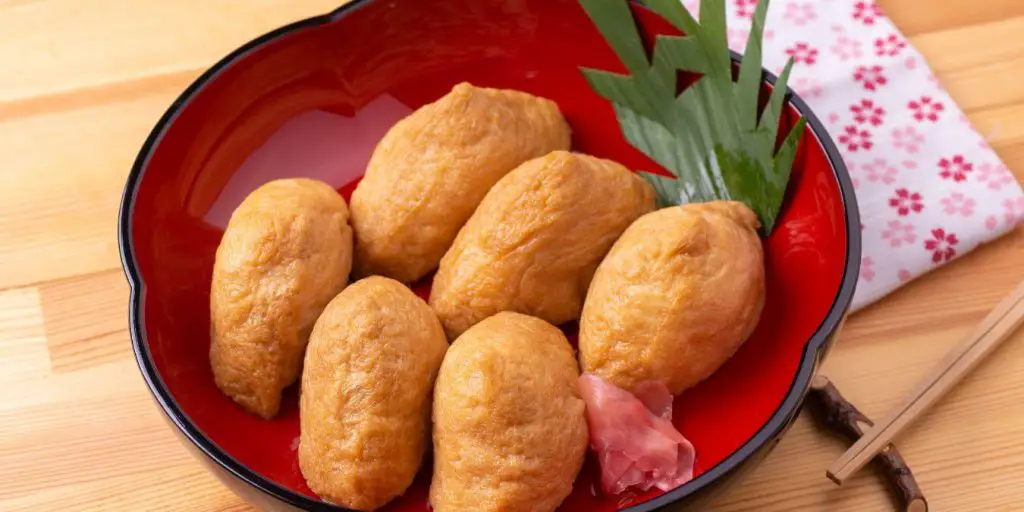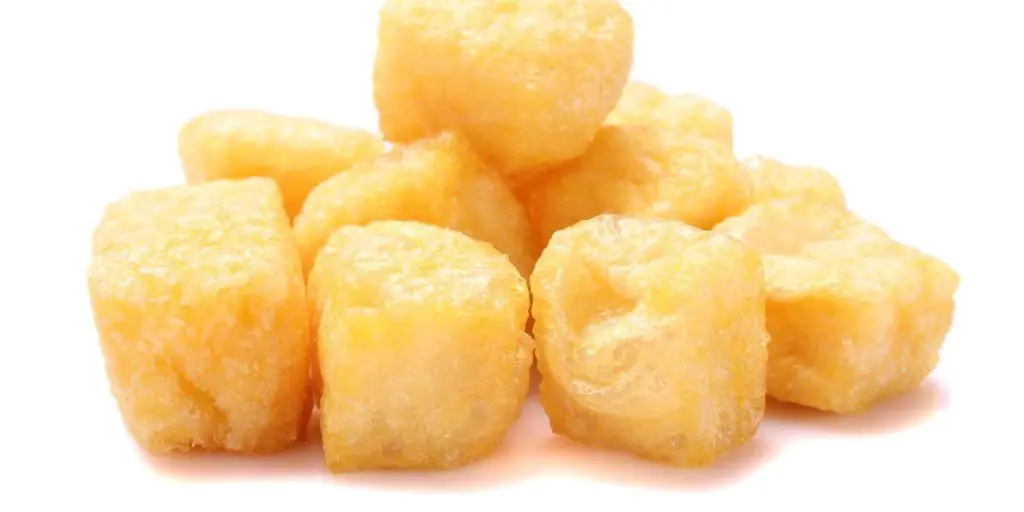A great source of protein, tofu has been a part of Asian diets for millennia. This versatile food with soybean roots became more common in Western dishes with the growing popularity of vegetarian diets and Buddhism in the late 20th century.
In a world seeking sustainability, tofu offers the ideal plant-based alternative that leaves a healthy ecological footprint and offers great taste. What does tofu taste like? The answer depends on the type of tofu and how you prepare it.
Types of Tofu

Tofu traces its origins to washed and soaked soybeans that are ground into a powder. Water is added to the ground soybean pulp and simmered. The resulting mixture flows through a cloth sieve. This soy milk is coagulated while heated again at a lower temperature to create the curds.
A 100% plant-based product, the type of tofu depends on the amount of water added to the pulp, the coagulant used, and the amount of time the curdled product is pressed. The name of this product relates to this process, with “to” meaning bean and “fu” referring to the fermenting or curdling process the beans endure.
Tofu types are defined by the relative moisture, texture, and amount of pressure applied to the curds.
Silken Tofu
Sometimes called “Japanese-style tofu,” silken tofu resembles a custard and holds the greatest amount of water. Due to its creamy quality, silken does not maintain its shape very well, breaking into pieces in your hand, similar to soft gelatin.
Silken tofu commonly appears in Japanese dishes, such as miso soup. Depending on its moisture, silken tofu may be used in dips, sauces, dressings, puddings, and smoothies. As a vegan egg substitute, it has even been added as an ingredient in cheesecakes and ravioli fillings. A popular Vietnamese dessert combines silken tofu and ginger syrup to create a sweet soup.
Soft Tofu
Soft tofu is another name given to tofu with a silken, still spongy composition, especially when used in Chinese or Southeast Asian dishes. Resembling pudding or yogurt, this moist tofu is also an excellent addition to soups.
A bit more compact than its silken cousin, soft tofu quickly absorbs flavors and marinades. This characteristic makes it a perfect addition to soups, broths, and other dishes where the infusion of flavor is more important than a firm texture. Soft tofu tends to break apart if fried.
Medium Tofu
Perfect for saucy dishes and curries, medium tofu also enhances miso soup. Somewhat delicate, this tofu has greater density than soft or silken tofu. For some dishes, medium tofu may be a substitute for firm tofu.
Firm Tofu
Perfect for stir-frying or pan-frying, firm tofu also works well when crumbled into dishes that include a tofu scramble and absorbs flavors added to it. The most versatile type of tofu, firm types of tofu are widely available in grocery stores, including locations that may not have large Asian food selections.
Firm tofu should be dried before cooking, to allow it to absorb any marinade you want to add. Consider firm tofu as a meat substitute for smoked or seasoned entrées, as well as deep-fried dishes and stews.
Extra-Firm Tofu
Less moist than firm tofu, this type can be cubed or sliced for frying. You may also crumble, grill, or bake extra-firm tofu. The texture may be slightly different than firm tofu. Extra-firm does not absorb the complexities of sauces and marinades as well as less firm types.
Super-Firm Tofu
Very little water remains in this very dense tofu, one that maintains its shape very well, as well as a high protein content. Great for those who want to fry or bake their cubes without needing the effort to dry them, super-firm tofu has a tendency to burn quickly since it has less liquid to release when heated.
Super-firm tofu’s texture may resemble packaged cheese or cubes of meat. Due to the lack of water, some brands sell this type of tofu in vacuum-packed wrappings rather than sitting within small tubs with water.
Pre-Packaged and Prepared Options

Those who want to sample tofu options before trying to experiment with drying, cutting, and cooking unflavored tofu on their own should check with their grocery or health foods store. Some of these locations may have seasoned packages of tofu strips or cubes in the frozen foods section near other vegetarian entrees.
Asian markets – especially those that specialize in selling Chinese and Vietnamese products – may also have a variety of tofu cubes, including fried cubes with onions, mushrooms, lemongrass, and peppers. Vietnamese delicatessens that feature tofu and soy-based products are sometimes known as stores that sell “đậu hủ.”
Similar to unique kimchi or barbeque recipes, individual locations may add their own unique touch to their pre-packaged or deli tofu selections. Here are some common options that illustrate tofu’s flexibility:
Pre-Seasoned Options

Similar to grab-and-go sushi, pre-seasoned tofu comes in packages and sometimes can be selected similar to salad or olive bars at a grocery store. Whether seasoned in tamari or soy sauce, or available in warm, fried cubes with lemongrass and Thai chili, these pre-seasoned selections can be added to rice, breads, soups, stews, and other dishes to take the place of meat. Seasoned tofu may be cooked or eaten raw.
Some pre-cooked and marinated selections are known as tofu à la minute. They may be infused with herbs, spices, or marinades from Asia, Mexico, Italy, or practically any other culture. Those who enjoy Vietnamese bánh mì sandwiches can order vegetarian versions with tofu slices as the primary protein, rather than meat.
Pressed Tofu
Some locations sell tofu selections that have been pressed to the point that they have very little moisture and a texture that resembles meat or mock meat selections made from gluten. Whether naturally flavored or seasoned, pressed tofu may be modified to mimic the texture and taste of steak, chicken, scallops, and many other meats or proteins.
Vegan options continue to improve. Years ago, few people would have thought of pizzas having a crust made from cauliflower. Today, you can find seasoned french fries made from tofu, rather than potatoes.
Fermented Tofu

Similar to fermented cucumbers that become pickles, or the fermented daikon radish and carrots often added to bánh mì sandwiches, tofu can be prepared with rice wine, salt, and water to create a savory dish that has a flavor the Japanese call umami. Chinese dishes sometimes incorporate fermented tofu to add flavor to a meal.
Fermenting or pickling may also involve miso, soy sauce, vinegar, and other ingredients, creating a smell and flavor that can be mild or pungent, based upon a person’s preference.
Tofu Skin

Whether fresh or dried, tofu skin is popular in Chinese, Korean, and Japanese dishes. Soya milk, when heated, creates a skin on its surface. Depending on its thickness, this skin may resemble filo pastry.
Tofu skins offer great flexibility for dishes. Similar to spring rolls, it may serve as a foundation similar to rice paper. Whether resembling filo dough, mock meat, or used in dim sum, recipes that use tofu skin expand the options available for this soybean-based product.
Tofu Sticks
These sticks may be made of rolled tofu skins that are baked or sun-dried. Crispy, breaded tofu sticks may offer another type of meat-free protein.
Tofu Pockets

Most people encounter tofu pockets in Japanese restaurants or Chinese buffets with sushi tables. Sometimes known as inari, this tofu is created when twice-fried soybeans — known as abura-age — are marinated in sugar, soy sauce, and mirin, before being filled with tasty sushi rice.
These small pockets, sometimes available in refrigerated sections of Asian markets, have a sweet taste and are a popular sushi item.
Tofu Puffs

Frozen and deep-fried, these small puffs are perfect for dipping. Common in Japanese and Thai dishes, they are wonderful with rice, in stews and soups, or as a snack when dipped in a favorite sauce.
Fried Tofu
Pressed and deep-fried, this tofu can be used in numerous dishes as a protein. Often available in a pre-seasoned form, fried tofu comes in many variations to meet the tastes of different cultures.
Basic Preparation Steps
If you are ready to make your own tofu dishes, there are a few important steps you should take before you cook, bake, or fry your tofu.
Draining: An Important First Step
For most tofu dishes – and all of them that involve baking or frying – you should drain and pat the tofu dry. Some people remove the tofu and cover it with a towel to dry it immediately; others place the tofu block in the refrigerator for a little time before cutting and draining any remaining liquid.
Your goal is to get the tofu dry enough so you can cut it into the desired shapes. The Chinese method involves cutting the tofu into the preferred shapes and boiling the pieces for a few minutes, before draining them in a colander.
Cutting: Creating the Perfect Size

Tofu taste and texture are influenced by how a person slices the pieces. Thinner pieces absorb more marinade or oil, and have a crispier consistency. Although even a butter knife will cut tofu, the best way to slice it into smaller pieces is with a sharper meat knife. Glide the knife like you are slicing a piece of cheese, rather than pressing it down.
Other cutting techniques include the following:
- Scrambling: To mince the tofu into the consistency of a scrambled egg, simply drain, crumble with a fork, and marinade as desired for approximately 15 minutes.
- Puréeing: Silken, regular, and firm tofu may be puréed with a potato masher, blender, or food processor. The amount of moisture determines whether the texture is smooth or coarse. Add spices for a tasty dip.
- Grating: For those who enjoy adding tofu to their salads or other dishes, grating or finely chopping is an option for firm tofu.
- Tearing: Those who enjoy cooking with the firmest tofu types may prefer to tear the cube into smaller, irregularly sliced chunks instead of slicing it.
Marinating: Adding the Perfect Flavor

Some critics condemn tofu for its supposedly bland taste and texture. By draining it to the preferred dryness, cutting it into the desired shape, and infusing it with flavor, you can create the perfect dish or dessert.
Tofu absorbs the flavors you add:
- Add It Raw: When placed in a broth to simmer or stew, tofu absorbs the flavor.
- Infuse Flavor: Soy sauce, rice wine, spices, curry sauce or powder, sriracha, lemon juice, and balsamic vinegar are a few of countless options. Ginger syrup on silken tofu creates a sweet, soupy dessert.
- Sugary Sweet Crusts: Honey, sugar, or syrups add a sweet crust, perfect for cubes fried with slightly toasted sesame seeds.
- Salt: Either add salt directly or use a salty sauce. Soy sauce, Vietnamese fish sauce (nước mắm) or its vegetarian substitute (nước mắm chay) work perfectly.
- Oils: Generally speaking, oils make poor marinades, because their thickness may prevent the inside of the cubes from absorbing other flavors; cooking with oil is an option, however.
Creating the Perfect Dish
The level of firmness determines the best cooking technique:
- Silken and regular: heated, steam, raw
- Firm and Extra-Firm: grill, barbeque, roast, deep-fry, scramble, stir-fry, pan-fry, stew, steam, raw
- Super-Firm: grill, barbeque, deep-fry, fry, raw
Preparation Methods
- Eat It Raw: Perfect for smoothies, dips, salads, and stews.
- Stewing: Add moist pieces to a favorite sour or stew.
- Choose Your Oil: Peanut oil works best for Asian dishes. Other options include olive oil, sunflower oil, coconut oil, and dairy-based ghee (for non-vegan dishes).
- Scrambled: Pan-fry veggies or other ingredients to the desired texture, then add crumbled tofu and sauces.
- Steaming: Maintain a velvety texture with regular or silken tofu.
- Stir-frying: Marinate, add a little oil, and place in a wok or large pan.
- Baking: For nugget-style meals with crispy outsides.
- Deep-frying: A golden-brown outside with a soft inside. Dip the firmer types of tofu cubes in flour or dry them before frying to prevent the splattering of oil.
- Smoked and Grilled: Extra-firm and super-firm pieces may even be grilled, marinated with a brush, and crafted into a vegetarian barbeque.
Diverse and Delicious
Far from being a bland protein, tofu can serve as a healthy substitute for so many menu items. Depending on its firmness and preparation, here are just a few examples of food items that tofu can substitute for or enhance:
- Chili
- Dips
- Dressings
- Eggs
- French fries
- Ground beef
- Lassi
- Mousse
- Sauces
- Scrambles
- Smoothies
- Taco “meat”
- Vegan “mayo”
Give tofu a try! You will enjoy it.
